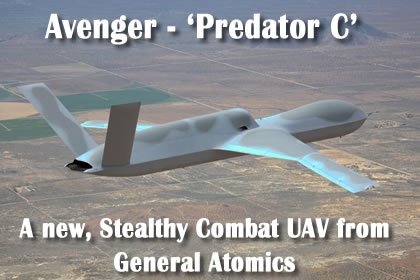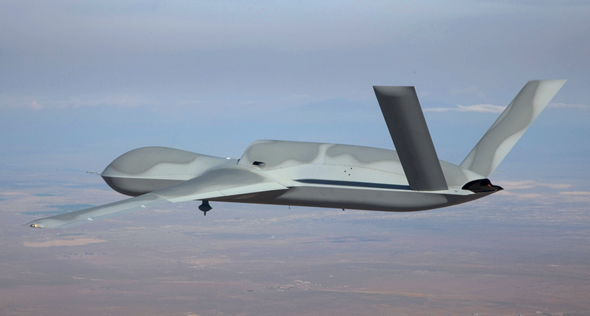
UAV manufacturer General Atomics began flight testing of a larger, stealthier UAV dubbed as the ‘Avenger’. Formerly known as ‘Predator C’, the new jet powered UAV made its first flights Apr. 4, 2009. The UAV’s shape reflects the designer’s goal to reduce the aircraft electromagnetic and thermal signature. It is powered by a single Pratt & Whitney Canada PW545B engine feeding from the curved dorsal intake, reducing radar reflections from the turbine blades. The exhaust is partly shielded by the V-tail which also reduces the aircraft thermal signature while serpentine exhaust eliminates radar reflections from inside the engine. The Avenger is designed to fly a 20 hour mission. The Avenger is designed to operate at altitude up to 60,000 ft and cruising speed of 400 knots.

The unmanned aircraft can take different payloads weighing up to 3,000 lbs., including EO, radar, and electronic payloads, as well as weapons (typical weapons carried could include GBU-38 Laser/JDAM), stored in an internal weapons bay and underwing. For stealthy missions all weapons are carried internally. Aircraft sensors will include the Lynx Synthetic Aperture Radar (SAR) developed by General Atomics and various Electro-optical/Infrared (EO/IR) camera systems. For special mission applications the Avenger could also perform stealthy recce missions, utilizing a semi-submerged wide-area surveillance payload configured to fit into the weapon’s bay. According to General Atomics, a recce system based on Lockheed Martin’s F-35 FLIR is currently being evaluated, as well as an in-house full-motion video sensor. On non stealthy missions the bay can be used to carry fuel for additional 120 minutes of flight. To maintain the clean, stealthy underside, the Avenger would probably rely on specialized integral, conformal or retractable payloads.

According to the manufacturer, Avenger presents a no risk/low-cost procurement option as it employs the same proven materials and avionics as Predator B and is controlled from and fully compatible with the the General Atomics Ground Control Stations (GCSs) already used to control all Predator-series aircraft currently in use by U.S. forces and allied military services.
The Avenger represents the third level in the development of U.S. Air Force unmanned, tactical combat capability. First was the piston-engine Predator A (MQ-1) which was modified to carry laser guided weapons (Hellfire). The second generation was the turboprop powered Reaper (Predator B MQ-9), designed from the start with weapons carrying capability, higher speed and ceiling. The new Predator C adds stealth performance, lacking with previous designs, bringing USAF unmanned assets in line with 5th generation aircraft such as the F-22 Raptor and F-35 Lightning II. According to Aviation Week’s David Fulghum, the initial target customers would be the USAF and RAF. The prototype was equipped with a tail hook, hinting on possible future naval carrier based testing. The hook can also shorten landing run, particularly useful when operating from forward operating bases.
















